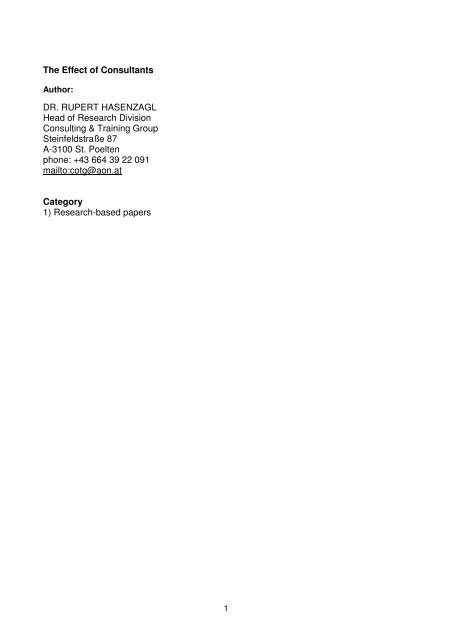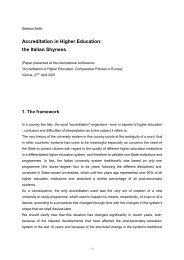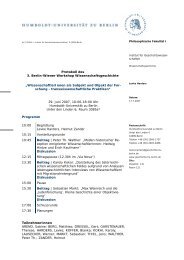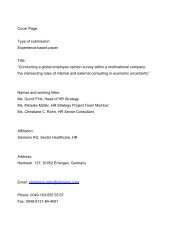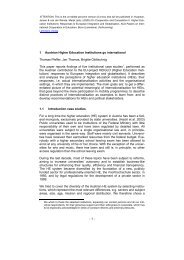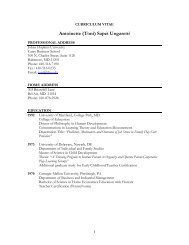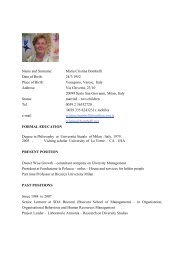The Effect of Consultants DR. RUPERT HASENZAGL Head of ...
The Effect of Consultants DR. RUPERT HASENZAGL Head of ...
The Effect of Consultants DR. RUPERT HASENZAGL Head of ...
You also want an ePaper? Increase the reach of your titles
YUMPU automatically turns print PDFs into web optimized ePapers that Google loves.
<strong>The</strong> <strong>Effect</strong> <strong>of</strong> <strong>Consultants</strong><br />
Author:<br />
<strong>DR</strong>. <strong>RUPERT</strong> <strong>HASENZAGL</strong><br />
<strong>Head</strong> <strong>of</strong> Research Division<br />
Consulting & Training Group<br />
Steinfeldstraße 87<br />
A-3100 St. Poelten<br />
phone: +43 664 39 22 091<br />
mailto:cotg@aon.at<br />
Category<br />
1) Research-based papers<br />
1
<strong>The</strong> <strong>Effect</strong> <strong>of</strong> <strong>Consultants</strong><br />
Abstract<br />
Consulting is a very important branch for the economy <strong>of</strong> a region. In the last view years,<br />
the literature which analyzes this growing branch has been increasing. In this paper a<br />
contribution to the micro level theories about consulting is delivered. <strong>The</strong> question how the<br />
effect <strong>of</strong> consultants can be explained, leads to different types <strong>of</strong> theoretical approaches to<br />
describe the client-consultant relationship. Three different models are outlined to estimate<br />
the effects <strong>of</strong> consultants and used to distinguish two types <strong>of</strong> consultants. Furthermore we<br />
show the application <strong>of</strong> these models with help <strong>of</strong> two case studies.<br />
1. Introduction and research question<br />
Consulting 1 was in the past one <strong>of</strong> the most growing branches in the western economies<br />
(Buono, 2001b: vii; McKenna, 1995: 51). But not only has the size <strong>of</strong> the branch<br />
constituted its importance. It has also been the influence on the economics <strong>of</strong> a region<br />
(Fincham & Clark, 2002: 3). Contrary to this importance, the theoretical basis <strong>of</strong> consulting<br />
is astonishingly poor. In the past twenty years some theory fragments could be found, but<br />
a general theory <strong>of</strong> consulting which should define the important parameters and help to<br />
describe the interaction between these parameters is still missing (Hasenzagl, 2007: 357).<br />
Six years ago we started a research project at the University <strong>of</strong> Applied Sciences in<br />
Wiener Neustadt. 2 <strong>The</strong> aim was to deliver contributions to both fields <strong>of</strong> consulting<br />
research:<br />
(1) <strong>The</strong> macro level research in which the structure and the dynamics <strong>of</strong> the consulting<br />
branch, especially in Austria, are analyzed (Egger, Häfke-Schönthaler, Hasenzagl, &<br />
Stocker, 2008; Egger, Hasenzagl, Stocker, & Wagner, 2004; Egger, Hasenzagl, Stocker, &<br />
Wagner, 2006; Hasenzagl & Kainz, 2008).<br />
1 When we use the term “consulting” in this paper, we speak about “management consulting (MC)”. This is<br />
also a broad field (Watson, Rodgers, & Dudek, 1998: 496). We see the organizations as clients <strong>of</strong> MC and<br />
the functional range <strong>of</strong> the activities is shown e.g. in the management process (Robbins & Coulter, 2002).<br />
2 <strong>The</strong> author was Pr<strong>of</strong>essor and head <strong>of</strong> the department until January 2009 and responsible for the research<br />
project.<br />
2
(2) <strong>The</strong> micro level wherefore conceptual and empirical work is done to explain the (social)<br />
interaction within the client-consultant relationship (e.g. Dietrich, Frank, Güttel, &<br />
Hasenzagl, 2005; Hasenzagl, 2004, 2007; Hasenzagl, Falkner, & Hatvan, 2006).<br />
<strong>The</strong> paper at hand is a typical micro level research. It is aimed at answering the question,<br />
how the effect <strong>of</strong> consultants can be explained. <strong>The</strong>refore different concepts for effect<br />
modelling are shown. <strong>The</strong> suggested models are quite diverse and result from different<br />
theoretical backgrounds (basis theories) which are used to describe consulting. <strong>The</strong> basic<br />
assumptions could be a-theoretical “every day concepts” (naive theories), common basis<br />
theories like economics (in the sense <strong>of</strong> business administration), or systems theory etc.<br />
2. Micro level consulting theories<br />
Analyzing the different types <strong>of</strong> knowledge which are necessary for pr<strong>of</strong>essional consulting<br />
on micro level, we <strong>of</strong>ten find in literature two types <strong>of</strong> underlying theories: theories for<br />
consulting and theories about consulting 3 (Groß & Kieser, 2006: 88; Hasenzagl, 2007).<br />
<strong>The</strong> first one should enable consultants to get a sophisticated perception <strong>of</strong> an<br />
organization which fits well with the complexity <strong>of</strong> his tasks. <strong>The</strong>se types <strong>of</strong> theories are<br />
not different to the theories which are necessary for managers, but the experience <strong>of</strong> a<br />
consultant in using some <strong>of</strong> these theories should be larger than the manager’s one.<br />
However, the constitutional difference between consulting and management is located in<br />
the second type <strong>of</strong> theories: the theories about consulting. In these micro level theories the<br />
(social) interaction between consultant and client is described as well as the<br />
interdependence with other relevant parameters. <strong>The</strong>se parameters are shown in Figure 1.<br />
3 Cf. Hasenzagl & Mitterer „Pr<strong>of</strong>essionalism in Consulting” at this conference.<br />
3
Legal parameter<br />
furtherances<br />
Consultant<br />
Consulting branch<br />
Competitors<br />
Contract<br />
Consulting approach<br />
Methods<br />
Contractee<br />
Problem<br />
Consulting System<br />
<strong>Effect</strong><br />
Role<br />
Interventions<br />
4<br />
Economic enviroment<br />
<strong>of</strong> the client‘s branch<br />
Relationship<br />
Values<br />
View <strong>of</strong> problem<br />
Client<br />
Type<br />
Other environmental factors<br />
Figure 1: Parameters <strong>of</strong> a micro theory about consulting (cf. Hasenzagl, 2007)<br />
A very important part in this model is the “consulting system” which is built <strong>of</strong> the<br />
consultant and the client (-systems). 4 This consulting system is the institutional frame for<br />
the interventions <strong>of</strong> the consultants and therefore for his impact and effect. Usually we<br />
have different consulting systems within a project (Dietrich et al., 2005; Hasenzagl, 2007).<br />
In the case <strong>of</strong> organizational change projects, the consulting system normally is generated<br />
from the consultant-system and a delegation system <strong>of</strong> the client which is a small group <strong>of</strong><br />
the organization’s members (Hasenzagl, 2007: 358).<br />
In 1991, Steyrer stated, that a general theory about consulting, which takes into account<br />
the interdependent and circular linkage <strong>of</strong> the relevant parameters <strong>of</strong> consulting as shown<br />
in Fig. 1 is missing (Steyrer, 1991: 7). This opinion has remained within literature until<br />
today. It has <strong>of</strong>ten been criticized that contrary to the growth <strong>of</strong> consulting and its influence<br />
on the society (Watson et al., 1998: 495) these theories have been underdeveloped<br />
(Hasenzagl, 2007; Lundberg, 2002: 153; Wimmer, 1991: 116). Fincham pointed out, that<br />
4 Cf. the “contact system” by Luhmann: “A new system arises out <strong>of</strong> communication: the contact system <strong>of</strong><br />
the consulting relationship.” (Luhmann, 2005c: 360).
the knowledge base <strong>of</strong> consulting is not sufficient: “<strong>The</strong> critical literature in particular has<br />
questioned how a non-codified body <strong>of</strong> knowledge like ‘consultancy’ could become<br />
apparently influential.” (Fincham, 1999: 335). Lundberg summarized “[…] the field remains<br />
relatively underconceptualized and some would say even a-theoretical […]” (Lundberg,<br />
2002: 153). However, in the last years, some research activities could be observed in this<br />
field (Mohe, 2008: 41). <strong>The</strong> publication <strong>of</strong> books and papers dealing with consultancy from<br />
a rather popular point <strong>of</strong> view (e.g. Leif, 2006) or written for the practitioners' market (Kubr,<br />
2002) has also increased like scientific literature in journals or books (Buono, 2001a, 2002;<br />
Clark & Fincham, 2002; Kipping & Engwall, 2002). Especially papers which focus on the<br />
client-consultant relationship deal with an essential part <strong>of</strong> the micro theory about<br />
consulting and fit well with the point <strong>of</strong> view <strong>of</strong> the model shown in Fig. 1 (Fincham, 1999;<br />
Luhmann, 2005c; Werr & Linnarsson, 2002).<br />
Following this line <strong>of</strong> research, we will analyze how the effects <strong>of</strong> consultants can be<br />
explained or understood. <strong>The</strong> institutional frame for this analysis is the model shown in Fig.<br />
1. Debating this research question, we build on the recent consulting literature and use<br />
previous results <strong>of</strong> our own research projects to develop different models to explain and<br />
understand the effect <strong>of</strong> consultants. <strong>The</strong> different models are the result <strong>of</strong> distinct<br />
underlying basis theories. Thus, we show the different levels <strong>of</strong> theories in more detail in<br />
the next part. This is necessary to distinguish different points <strong>of</strong> view concerning effects <strong>of</strong><br />
consultants.<br />
3. Levels <strong>of</strong> theories<br />
In the last chapter we have shown a theory that deals with a special subject, namely<br />
consultants. <strong>The</strong>refore we call this theory level the subject one (Figure 2).<br />
5
Fig. 2: Levels <strong>of</strong> <strong>The</strong>ories<br />
<strong>The</strong> lowest level is the philosophy <strong>of</strong> science position. Typical possibilities are objective vs.<br />
subjective, descriptive vs. normative positions. A well-known model to describe such<br />
positions is the Burrell-Morgan scheme. A specific theory on this level is e.g. the<br />
constructivism. On the next level, the level <strong>of</strong> basis theory we find the basic assumptions<br />
(e.g. concerning organizations and individuals). Typical theoretical positions are the<br />
economic view or the systems theory <strong>of</strong> Luhmann. <strong>The</strong>se two theory levels determine the<br />
frame for the subject level where a specific part <strong>of</strong> reality is modeled. Such parts could be<br />
leadership, organizational change or consulting. Above the dotted line we find practice with<br />
technologies, techniques or tools. If these tools are derived from theories, they normally<br />
have a higher quality than tools generated without a theoretical basis just from (non-<br />
methodical) observations in practice.<br />
4. Models to explain the effect <strong>of</strong> consultants<br />
<strong>The</strong> theory level model shown in Fig. 2 is used to explain different models <strong>of</strong> the effect <strong>of</strong><br />
consultants. First, we analyze the effect model in practice, founded on a-theoretical<br />
assumptions. Furthermore we use an economics point <strong>of</strong> view on the level <strong>of</strong> basis<br />
theories to generate an effect model as part <strong>of</strong> a micro theory about consulting on the<br />
subject level.<br />
6
4.1 A-theoretical and economic model<br />
In a first model a widespread a-theoretical practitioner idea <strong>of</strong> effective consulting is<br />
discussed. This model is characterized by using only contentual aspects to define effects.<br />
Some studies (e.g. Kainz, 2008: 26) show that in practice the majority <strong>of</strong> consultants<br />
(about 70%) is convinced to be mainly hired by clients due to the consultant’s knowledge.<br />
A quantitative survey shows that clients take a similar point <strong>of</strong> view (Kainz & Torggler,<br />
2008: 275). Comparable results (although with a lower percentage) were presented by<br />
Poulfeld & Payne for the Danish consulting market. “To provide expertise, knowledge and<br />
new methodologies” (Poulfelt & Payne, 1994: 426) is named by clients as well as by<br />
consultants to be one main motive for using consultants.<br />
<strong>The</strong> question is which type <strong>of</strong> expertise or knowledge is asked for by the client to such a<br />
high amount. Werr & Linnarsson point out as a result <strong>of</strong> their qualitative study, that the<br />
focus <strong>of</strong> clients is “[…] placed on the quick solving <strong>of</strong> the identified problems.” (Werr &<br />
Linnarsson, 2002: 25). However, they assume this to be on the level <strong>of</strong> “espoused<br />
theories” 5 , whereas the “theory in use” reflects a more sophisticated client-consultant<br />
learning-oriented relationship. In order to be able to distinguish those two types <strong>of</strong> theories<br />
and to interpret the “theory in use” as mentioned by Werr & Linnarsson we see the<br />
necessity <strong>of</strong> a sophisticated theoretical basis, which cannot be found, neither in<br />
consultancy nor in management 6 .<br />
In practice, this rather a-theoretical ”expert role” <strong>of</strong> consultants with a mechanistic<br />
understanding <strong>of</strong> organizations is <strong>of</strong>ten combined with the assumption that the effect (E) <strong>of</strong><br />
consulting is primarily caused by the contentual quality (Q) <strong>of</strong> the consultant’s actions.<br />
E = Q (1)<br />
This effect-quality equation is assumed to be true, if basis theories are “classical”<br />
economics oriented, like within an important stream <strong>of</strong> business administration. Such<br />
economic theories <strong>of</strong>ten have the paradigm <strong>of</strong> “methodological individualism” and the idea<br />
5<br />
<strong>The</strong> terms “espoused theory” and “theory in use” are taken from the well-known learning concept <strong>of</strong> Argyris<br />
& Schön.<br />
6<br />
Cf. e.g. the paper on “Pr<strong>of</strong>essionalism in Consulting” from Hasenzagl & Mitterer at this conference.<br />
7
<strong>of</strong> “rational decision making” on the level <strong>of</strong> philosophy <strong>of</strong> science 7 . Thus, only one<br />
dimension <strong>of</strong> the social occurrence is taken into account: the content.<br />
We assume that the great influence <strong>of</strong> economics on management practice is the main<br />
reason for the domination <strong>of</strong> the mechanistic rational organization metaphor in practice<br />
(Wimmer, 2004: 163) as mentioned above 8 . As far as the effect <strong>of</strong> consultants is<br />
concerned, the explanatory power <strong>of</strong> economics-based approaches does not seem to be<br />
significantly higher than the one <strong>of</strong> the practitioner model.<br />
4.2 A social-psychological model<br />
A first enhancement <strong>of</strong> the simple assumptions shown in eq. (1) can be reached by taking<br />
an “irrational” behaviour <strong>of</strong> clients into account. <strong>The</strong>reby additional social psychological<br />
aspects are considered; this type <strong>of</strong> effect model is <strong>of</strong>ten used in literature (e.g.<br />
Grossmann & Scala, 2002: 57). <strong>The</strong> contentual aspects (quality) as well as the social<br />
aspects <strong>of</strong> the client-consultant relationship (acceptance) are reflected to explore effects <strong>of</strong><br />
consultants. <strong>The</strong> basis theory <strong>of</strong> such a perspective on effect is normally a kind <strong>of</strong> social-<br />
psychological one. Using these assumptions, effect can be calculated as the product <strong>of</strong><br />
quality and acceptance:<br />
E = Q x A (2)<br />
Within this concept, the “social competence” <strong>of</strong> the consultant plays an important role. It is<br />
<strong>of</strong>ten assumed, that a high degree <strong>of</strong> “social competence” can increase the probability to<br />
receive acceptance for a consulting intervention. In eq. (2) two dimensions <strong>of</strong> social<br />
occurrence are considered: the content and the social dimension.<br />
7 In the literature there is a discussion within the business administration school concerning other positions<br />
on the philosophy <strong>of</strong> science level (see the discussion <strong>of</strong> equation 2). But especially within consulting and in<br />
German speaking Europe, we <strong>of</strong>ten find the above mentioned “rational” oriented position which in many<br />
cases underestimates the complexity <strong>of</strong> organizations (Wimmer, 2004: 167).<br />
8 This mechanistic point <strong>of</strong> view in management practice is especially reflected in the widespread use <strong>of</strong> the<br />
deterministic contingency approach. One important example for the unreflected use <strong>of</strong> this approach is<br />
Business Process Reengineering (BPR) (Hasenzagl, 2006: 309).<br />
8
Social psychology is also the basis <strong>of</strong> the “classical” mainstream <strong>of</strong> the “Organizational<br />
Development (OD)” consulting approach. This approach is sharply separated from the<br />
economics or engineering approach <strong>of</strong> consulting. <strong>The</strong> latter was almost the only way <strong>of</strong><br />
doing consulting until the 1960s and is still playing a major role (cf. the above mentioned<br />
economic rational model). <strong>The</strong> radical new OD view requires a new understanding <strong>of</strong><br />
consulting. Thus, OD was the starting point <strong>of</strong> a (theoretical) reflection <strong>of</strong> consulting in the<br />
sense <strong>of</strong> a micro theory <strong>of</strong> consulting concerning e.g. the different roles and interventions<br />
(Schein, 1987, 1988).<br />
According to our empirical research, consultants name social competences as the most<br />
important ability; and their importance is assumed to further increase (Kainz, 2008: 28).<br />
That result points to the increasing importance <strong>of</strong> “acceptance” in practice. <strong>The</strong> “de-<br />
institutionalization” <strong>of</strong> consulting as a taken for granted requirement <strong>of</strong> modern<br />
management (Birke, 2007) can be a reasonable explanation for the increasing importance<br />
<strong>of</strong> acceptance. <strong>The</strong> above mentioned domination <strong>of</strong> the mechanistic organization<br />
metaphor (with an overestimation <strong>of</strong> the contentual quality) leads to the conclusion, that<br />
the main part <strong>of</strong> the practitioners uses “social techniques” to increase their acceptance.<br />
<strong>The</strong>y still follow the assumptions underlying eq. (1) and not social-psychological<br />
assumptions comparable to those <strong>of</strong> OD.<br />
<strong>The</strong> enhanced (theoretical) reflection and understanding <strong>of</strong> consulting within the OD<br />
approach leads to an improved effect model 9 as shown in eq. (2). However, internal limits<br />
<strong>of</strong> the social psychological basis theory (e.g. limits in the degree <strong>of</strong> complexity) and the<br />
application in OD as a subject theory (e.g. the normative image <strong>of</strong> humanity) limit its<br />
practical usability. <strong>Effect</strong>ive consulting in projects with high complexity (e.g. deep<br />
organizational change projects) requires a basis theory with a higher degree <strong>of</strong> internal<br />
complexity. Especially within the German speaking region, the social systems theory<br />
according to Luhmann has gained significant importance in consulting as a sophisticated<br />
basis theory. Thus, we use this basis theory for our next effect model. <strong>The</strong>refore we will<br />
9 Porras and Berg have shown a study concerning the impact <strong>of</strong> OD projects (Porras & Berg, 1978). But in<br />
this paper, the focus <strong>of</strong> the impact analysis is on the whole project and not on the effect <strong>of</strong> an intervention<br />
and/ or a concept like in our paper.<br />
9
give a short overview <strong>of</strong> essential basic assumptions <strong>of</strong> the systems theory which seem<br />
necessary to understand the effect model.<br />
4.3 Systems theory as basis theory <strong>of</strong> consulting<br />
<strong>The</strong> systems theory has not been very popular in the USA for the last three decades<br />
(Hessling & Pahl, 2006: 215). Recent publications indicate to a change <strong>of</strong> this situation.<br />
4.3.1. Systems theory according to Luhmann<br />
Systems theory has <strong>of</strong>ten been seen as a functional theory in the tradition <strong>of</strong> Talcott<br />
Parsons. But Luhmann’s theoretical point <strong>of</strong> view differs significantly from Parson’s<br />
approach. One major difference lies on the level <strong>of</strong> philosophy <strong>of</strong> science (analytical<br />
realism vs. constructivism). Luhmann’s theory was developed in different waves (Miebach,<br />
2006: 246); even the first step, the functional-structural theory (till 1979) included some<br />
enhancements, the final spin-<strong>of</strong>f from Parsons approach came with the introduction <strong>of</strong> the<br />
“concept <strong>of</strong> autopoiesis” and the theory <strong>of</strong> self-referential observation (Luhmann, 2005a,<br />
2005b). <strong>The</strong> position <strong>of</strong> Luhmann’s theory within the sociological theories is seen very<br />
distinct. Opinions range from a descriptive “classical” theory to a theory with a lot <strong>of</strong><br />
connections to “state <strong>of</strong> the art” sociological theories, even postmodernism (Hasse, 2005;<br />
Koch, 2005). However, it is recognized as a very powerful theory due to its great internal<br />
complexity. Although the discussion has been fruitful in the last years, it has shifted from<br />
the theoretical point <strong>of</strong> view to the practical application <strong>of</strong> the theory. Since the mid 1980s,<br />
a number <strong>of</strong> papers and books have been published with applications <strong>of</strong> the systems<br />
theory especially in management consulting as well as in management (e.g. Exner,<br />
Königswieser, & Titscher, 1987; Hasenzagl, 2007; Luhmann, 2005c; Seidl & Mohe, 2007;<br />
Vos, 2005). Since the early 2000s our research in the Austrian consulting market has<br />
shown that about the half <strong>of</strong> the consultants see at least an influence <strong>of</strong> the systems theory<br />
(especially by using “systemic” tools and techniques) in their work (Hasenzagl & Kainz,<br />
2008: 297).<br />
This short introduction is intended to show the potential power <strong>of</strong> this basis theory,<br />
whereby both types <strong>of</strong> theories – for and about consulting – are affected. At one hand<br />
within the theories for consulting the systems theory is a powerful basis for management<br />
10
theories (Steinmann & Schreyögg, 2005). On the other hand we see a considerable<br />
advantage <strong>of</strong> the systems theory when describing the interaction and interdependence <strong>of</strong><br />
the parameters in Figure 1. <strong>The</strong>reby systems theory functions as a basis theory for<br />
theories about consulting (on subject level cf. Fig. 2).<br />
Some key assumptions <strong>of</strong> the systems theory seem to be important to understand the<br />
effects <strong>of</strong> consultants. In systems theory, the elements <strong>of</strong> a social system are<br />
communications (Luhmann, 1995: 137-175). In that rather strange definition<br />
communication is seen as an emergent unit <strong>of</strong> three selections: information, utterance and<br />
understanding (Luhmann, 2005a: 66). In contrast to structuralism, Luhmann’s theory<br />
regards communication as an event that produces the subsequent event (the following<br />
communication). This operation <strong>of</strong> recreating communication that refers to the previous<br />
one, needs self-reference <strong>of</strong> the system (Luhmann, 2005a: 67). <strong>The</strong> elements under<br />
consideration which are “coordinated” (in the sense <strong>of</strong> complexity reduction) by structures<br />
<strong>of</strong> a social system are not behaviors <strong>of</strong> individuals; the elements <strong>of</strong> social systems are<br />
communications and not individuals and their behavior. Members <strong>of</strong> an organization are in<br />
this sense environment for the organization.<br />
Aside from the question “how” a communication is created (in our case as reaction to a<br />
further one), it is important “which” communication is produced. This is “[…] a question<br />
about the structures <strong>of</strong> social systems. Luhmann conceptualizes social structures as<br />
expectations […]” (Luhmann, 1995: 293; Seidl, 2005: 31). Structures make the following<br />
communication expectable and reduce complexity: not every communication is possible in<br />
the sense, that only a small range is meaningful for the system. Structures are not<br />
deterministic in a causal input/output understanding, they just “[…] make certain<br />
communications more likely than others […]” (Seidl, 2005: 31).<br />
<strong>The</strong> changing <strong>of</strong> the structures can only be performed by the system itself. Thus, the<br />
organization (as a special type <strong>of</strong> social system) is autonomous, although not autarkical.<br />
<strong>The</strong>refore organizations need irritations <strong>of</strong> their environments, especially by individuals<br />
(psychic systems (Luhmann, 1995: 59)). <strong>The</strong>se irritations (as the meaning extracted from<br />
the utterance by the organization, therefore the understood information is constructed by<br />
11
the organization itself) are necessary that communications emerge and the organization<br />
might learn by changing structures. <strong>The</strong> “structural coupling” <strong>of</strong> individuals conceptualized<br />
as psychic systems and a social system with an “interpenetration” <strong>of</strong> both systems is one<br />
<strong>of</strong> the important assumptions <strong>of</strong> Luhmann (Luhmann, 1995: 59; Seidl, 2005: 32). Similar<br />
ideas can be found in other concepts as well (e.g. structuration theory by Giddens).<br />
From a systems theory point <strong>of</strong> view a consultant can only irritate an organization and try<br />
to support the “self-learning effects”. In this sense, consultants can only have an effect, if<br />
the organization is able to understand a signal from the environment (in this case: the<br />
consultant) as information. “Understanding” is the third selection necessary for a<br />
communication to emerge. If the system does not understand information no<br />
communication occurs; information <strong>of</strong> the psychic system “consultant” cannot emerge to a<br />
communication and thus no further communication can follow. Since the information <strong>of</strong> the<br />
consultant has no “connectivity” within the organization, no further communication can<br />
“connect” to this information (because there is no prior communication). As noted before,<br />
the structures <strong>of</strong> the system “determine” which communication can follow or is expectable.<br />
Following these assumptions learning <strong>of</strong> a system can be modeled in a two step process:<br />
in a first step signals occur from the environment (e.g. a consultant) which are understood<br />
by the system as information. In the second step, the system processes the observed<br />
information within the system-inherent logic depending on the structures <strong>of</strong> the system.<br />
<strong>The</strong> result <strong>of</strong> this internal processing may be learning by the system in terms <strong>of</strong> changing<br />
its structures. 10<br />
4.3.2. <strong>Effect</strong> model based on the systems theory<br />
We pointed out that two steps are necessary within an organization to attribute an effect to<br />
a consultant within the systems theory:<br />
- Information by the consultant is observed by the organization. <strong>The</strong>refore a<br />
communication emerges which is “connectable” for further communications<br />
- A functional reaction <strong>of</strong> the organization.<br />
10 Similar assumptions can be found in literature about organizational learning from a systemic point <strong>of</strong> view<br />
(e.g. Klimecki, Laßleben, & Thomae, 2000).<br />
12
A functional reaction means that the organization changes its communication progress (by<br />
changing the underlying structures) and is thus more likely to reach its goals. A consultant<br />
has to estimate, which information is connective (Ca) and what the expected reaction <strong>of</strong><br />
the organization is. <strong>The</strong> quality (Qc) <strong>of</strong> the information is high, if the organization changes<br />
in the intended direction (functional in the above mentioned sense).<br />
E(t) = Ca(t) x Qc(t) (3)<br />
Three dimensions <strong>of</strong> social occurrences are considered in the systems theory and<br />
therefore in eq. (3): the contentual, the social and the temporal dimension. Again we see a<br />
rather social aspect (Ca(t)) and a more contentual aspect (Qc(t)) 11 . But the separation<br />
between these two dimensions is more analytical than in eq. (2). <strong>The</strong> third dimension - the<br />
time - is represented in eq. (3) by the term (t). Time is very important for the connectability<br />
as well as for the reaction <strong>of</strong> the organization (Qc(t)).<br />
This effect model requires <strong>of</strong> a consultant (a) to know the goals <strong>of</strong> the organization, and (b)<br />
to take these goals into account as well as (c) the connectivity and (d) the estimated<br />
reaction <strong>of</strong> the organization. A deep understanding <strong>of</strong> an organization in the sense <strong>of</strong><br />
hypothesizing its structures is inevitable to meet these requirements. A lot <strong>of</strong> systemic<br />
techniques and tools are applied in consultancy in German speaking Europe. However, we<br />
assume that the use <strong>of</strong> these tools is not always based on a deep understanding <strong>of</strong><br />
Luhmann’s theory 12 (Hasenzagl & Kainz, 2008: 297, 309). In our opinion the sole use <strong>of</strong><br />
tools without a connection to the complex underlying theory does not enable to build<br />
hypotheses concerning the reaction <strong>of</strong> the organization (for Ca(t) as well as for Qc(t) in eq.<br />
(3)). <strong>Effect</strong> can be attributed to the consultants, if the organization moves towards its<br />
goals.<br />
11<br />
For a comparable approach see e.g. Simsa and with respect to consulting Titscher (Simsa, 2001; Titscher,<br />
2001).<br />
12<br />
Luhmann calls this position „Strictly technical”, that “[…] means, in this context, ’without knowledge <strong>of</strong> the<br />
theoretical connections’.” (Luhmann, 2005c: 352).<br />
13
<strong>The</strong> consultant in a first step normally intervenes within the consulting system (cf. Fig. 1,<br />
also called ‘contact system’). Thus, the reaction <strong>of</strong> the organization to the interventions 13 <strong>of</strong><br />
the consulting system into the organization have to be considered as well (Hasenzagl,<br />
2007: 358). This highly complex situation cannot be analyzed without a theory which is<br />
able to model such complex social occurrences.<br />
Despite its high complexity, the model remains usable in practice, as shown in the<br />
following chapter.<br />
5. Application <strong>of</strong> the effect models<br />
First we show the definition <strong>of</strong> different types <strong>of</strong> consulting; in a next step we use these<br />
types to draft the results <strong>of</strong> two case studies.<br />
5.1 Different types <strong>of</strong> consultants<br />
Depending on the effect model and the basis theory referred to by the consultant (mostly<br />
implicit especially as practitioner and economics-based consultant), diverse types <strong>of</strong><br />
consulting can be distinguished. Two major groups <strong>of</strong> consulting approaches (see also:<br />
Schein, 2002: 24; Seidl & Mohe, 2007: 22; Werr & Linnarsson, 2002: 25) are identified<br />
which are characterized in Table 1 in more detail.<br />
Type 1: Economic and<br />
technical advisor<br />
Basic assumption An organization is a rational<br />
Contentual<br />
Dimension<br />
and trivial machine<br />
Main dimension, consultant<br />
is a contentual expert<br />
14<br />
Type 2: Management<br />
consultant<br />
An organization is a<br />
complex (non trivial) social<br />
unit<br />
Problem definition and<br />
solving conducted by the<br />
client, consultant enables<br />
13 Seidl & Mohe see the main intervention <strong>of</strong> the contact system in a second-order observation (Seidl &<br />
Mohe, 2007: 20). <strong>The</strong>refore the contact system observes the observations <strong>of</strong> the organization and “[…] has<br />
and can use (or not use) the possibility to see that which the observed observer cannot see.” (Luhmann,<br />
2005c: 357). We see a broader range <strong>of</strong> possible interventions <strong>of</strong> the consulting system (Dietrich et al., 2005:<br />
281/82; Hasenzagl, 2007: 358).
<strong>The</strong> problem definition and<br />
the concept is conducted by<br />
the consultant<br />
Social dimension Technical approach (social<br />
technology)<br />
Asymmetric relationship<br />
Temporal dimension Rather long projects<br />
Consultant knowledge Economics<br />
High degree <strong>of</strong><br />
standardization <strong>of</strong> methods<br />
Technical oriented (IT,<br />
Logistic)<br />
Applicability Rare problems with lack <strong>of</strong><br />
knowledge within the<br />
organization<br />
First order change (change<br />
<strong>of</strong> artifacts)<br />
Assumption about effect E = Q Eq. (1)<br />
E = Q x A Eq. (2)<br />
Table 1: Two types <strong>of</strong> consultants (cf. Hasenzagl, 2007)<br />
15<br />
new views<br />
Social aspects (structures)<br />
are in the focus<br />
Symmetric relationship<br />
Long projects but preferably<br />
short consultant<br />
employment<br />
Situational interventions<br />
<strong>The</strong>ories about consulting<br />
as basis for knowledge<br />
Sophisticated management<br />
theories based on powerful<br />
basis theories (theories for<br />
consulting)<br />
Unspecific problems<br />
with need for radical new<br />
solutions<br />
Second order change<br />
(“cultural change”)<br />
E(t) = Ca(t) x Qc(t) Eq. (3)<br />
Members <strong>of</strong> the first group operate with a rather simplified model concerning the<br />
consultant’s effects. This group prefers an “advice oriented” approach. <strong>The</strong>y want the<br />
clients to implement the consultant’s concepts and see the source <strong>of</strong> the consultant’s<br />
power in the contentual expertise. For the second group (we call them management<br />
consultant) one main aspect <strong>of</strong> the consultant’s role is to “enable” the clients to find their
own solutions. <strong>The</strong> presumed effect model in this group is more sophisticated and <strong>of</strong><br />
higher complexity.<br />
Furthermore the two type approach <strong>of</strong> consulting based on the effect models serves as the<br />
conceptual basis to analyze some empirical results <strong>of</strong> our previous work. On the one hand<br />
these practical cases enhance the understanding <strong>of</strong> the theoretical effect concept; on the<br />
other hand they show the usability <strong>of</strong> a sophisticated theoretical concept in practice. We<br />
give a short overview concerning the results, for a deeper insight see Hasenzagl (2007:<br />
356).<br />
5.2 Case studies<br />
In the first case study, the assumptions concerning the consulting system shown above<br />
can be strengthened. Furthermore in this empirical study the advantages <strong>of</strong> the second<br />
type <strong>of</strong> consultant (Tab. 1) for change <strong>of</strong> the second order become apparent.<br />
a.) <strong>The</strong> case study was conducted by a research team, using a hermeneutic method to<br />
interpret the change process second order within a regional development advisor<br />
(Dietrich et al., 2005). <strong>The</strong> interpretation showed clearly that the consulting system<br />
(cf. Fig. 1) which was differentiated as an interaction system with members <strong>of</strong> the<br />
consulting firm and a small group <strong>of</strong> the client organization had a very strong<br />
influence on changing the client organization on a cultural level. First <strong>of</strong> all, the<br />
clients group <strong>of</strong> the consulting system underwent a 2 nd order (cultural) change.<br />
<strong>The</strong>reafter this “strange” group induced a changing process within the organization.<br />
b.) In a second case study conducted in a research project leaded by the author,<br />
especially the two different types <strong>of</strong> consultants where used to analyze a consulting<br />
project with a hermeneutic approach as well (Grumböck, Horvath, & Schuster,<br />
2002). A large global enterprise had hired expert consultants to integrate the<br />
acquisition <strong>of</strong> a smaller firm. <strong>The</strong> consultants were typical type 1 consultants and<br />
members <strong>of</strong> the global “consulting industry”. <strong>The</strong> consultants elaborated an<br />
integration concept which was declined (in the sense <strong>of</strong> not implemented) by the<br />
client. An interview with a manager <strong>of</strong> the consulting firm revealed that he<br />
considered the project to be a failure. Interviews with the client showed a quite<br />
different picture. <strong>The</strong>y saw some learning effects with respect to their own<br />
16
integration concepts and thus the project did not really fail from their point <strong>of</strong> view.<br />
As mentioned above, we are speaking <strong>of</strong> a type 1 consultant. However, the client<br />
implicitly expected results <strong>of</strong> a type 2 consultant; they wanted impacts (irritations) to<br />
improve their own ideas concerning the integration. Thus, the consultant’s concept<br />
was not implemented, but it delivered some useful irritations for the client to learn.<br />
Two aspects <strong>of</strong> this project are especially worth a short discussion: First we see,<br />
that the failure rate <strong>of</strong> consulting projects, which is mentioned to be between 50%<br />
and 80% (for an literature overview see: Seidl & Mohe, 2007: 3) has to be<br />
scrutinized. Which consulting type respectively which effect model is used to see a<br />
project as failed? As shown above, a project can lead to a learning <strong>of</strong> the client,<br />
despite the refusal <strong>of</strong> the consultant’s problem solving concept. <strong>The</strong> refusal is a<br />
failure with respect to eq. (1) or (2), but could be successful with respect to eq. (3).<br />
Second different assumptions concerning clients learning are also mentioned by<br />
Werr & Linnarson. As shown above, they pointed out, that learning effects were not<br />
recognized by clients because these effects are on a processual (not contentual)<br />
and latent (tacit) level. In our empirical study we found the interesting case that the<br />
client saw the learning effects whereas the consultant did not!<br />
6. Reflection and research implications<br />
Results <strong>of</strong> this paper enable to understand the different assumptions about effects in the<br />
practice <strong>of</strong> consultancy and to reflect the success <strong>of</strong> consulting projects in a more<br />
sophisticated way. <strong>The</strong>refore our results contribute to the client-consultant relationship<br />
literature (e.g. Werr & Linnarsson, 2002) .<br />
Additionally, the results can be seen as a contribution to a general micro theory <strong>of</strong><br />
consulting. In this field some further research demand can be identified. To increase the<br />
pr<strong>of</strong>essionalism <strong>of</strong> the consulting branch, a general theory <strong>of</strong> consulting is desirable, at<br />
least theoretical models are indispensable (Lundberg, 2002: 171). Normally, the client-<br />
consultant interaction (which is the scope <strong>of</strong> such consulting theories) is very complex,<br />
especially on a social and temporal level. <strong>The</strong>refore an appropriate complexity <strong>of</strong> the<br />
consulting theories and therefore <strong>of</strong> the underlying basis theories seems necessary and<br />
the implementation <strong>of</strong> these theories in practice calls for an academic education. <strong>The</strong><br />
17
esults <strong>of</strong> the paper at hand were used in the past in academic education as well as in the<br />
training <strong>of</strong> consulting practitioners and met the requirements <strong>of</strong> these applications<br />
adequately.<br />
References<br />
Birke, M. (2007). Nach den Beratererzählungen - Ein Rück- und Ausblick auf den Wandel der<br />
Unternehmensberatung als gesellschaftliche Institution. Arbeit, 16(3), 231-245.<br />
Buono, A. F. (2001a). Current Trends in Management Consulting (Vol. 1). Greenwich, Connecticut:<br />
Information Age Publishing.<br />
Buono, A. F. (2001b). Introduction. In A. F. Buono (Ed.), Current Trends in Management<br />
Consulting (pp. vii-xiv). Greenwich, Connecticut: Information Age Publishing.<br />
Buono, A. F. (2002). Developing Knowledge and Value in Management Consulting (Vol. 2).<br />
Greenwich, Connecticut: Information Age Publishing.<br />
Clark, T., & Fincham, R. (2002). Critical Consulting. Oxford: Blackwell.<br />
Dietrich, A., Frank, H., Güttel, W. H., & Hasenzagl, R. (2005). Das Feuer kleiner Gruppen: Analyse<br />
der Entwicklungslogik und -dynamik eines Beratungsprozesses. Gruppendynamik und<br />
Organisationsberatung, 36(3), 271-284.<br />
Egger, W., Häfke-Schönthaler, J., Hasenzagl, R., & Stocker, F. (2008). Wirtschaftsberatung in<br />
Österreich . Markt und Branche, Struktur und Entwicklungen 2007/2008. Wien: Facultas.<br />
Egger, W., Hasenzagl, R., Stocker, F., & Wagner, C. (2004). Wirtschaftsberatung in Österreich:<br />
Struktur und Entwicklungen. Wien, Graz: Verlag NwV.<br />
Egger, W., Hasenzagl, R., Stocker, F., & Wagner, C. (2006). Wirtschaftsberatung in Österreich<br />
2005/2006. Markt und Branche, Struktur und Entwicklungen. Wiener Neustadt:<br />
Fachhochschule Wiener Neustadt.<br />
Exner, A., Königswieser, R., & Titscher, S. (1987). Unternehmensberatung – systemisch.<br />
<strong>The</strong>oretische Annahmen und Interventionen im Vergleich zu anderen Ansätzen. Die<br />
Betriebswirtschaft (DBW), 47(3), 265-284.<br />
Fincham, R. (1999). <strong>The</strong> Consultant-Client Relationship: Critical Perspectives on the Management<br />
<strong>of</strong> Organizational Change. Journal <strong>of</strong> Management Studies, 36(3), 335-351.<br />
Fincham, R., & Clark, T. (2002). Introduction: <strong>The</strong> Emergence <strong>of</strong> Critical Perspectives on<br />
Consulting. In T. Clark & R. Fincham (Eds.), Critical Consulting (pp. 1-18). Oxford:<br />
Blackwell.<br />
Groß, C., & Kieser, A. (2006). Are <strong>Consultants</strong> Moving towards Pr<strong>of</strong>essionalization? In R.<br />
Greenwood & R. Suddaby (Eds.), Pr<strong>of</strong>essional Service Firms (Vol. 24, pp. 69-l00).<br />
Amsterdam et al.: Elsevier.<br />
Grossmann, R., & Scala, K. (2002). Landkarten von Organisationen. In K. Scala & R. Grossmann<br />
(Eds.), Supervision in Organisationen (2. ed., pp. 35-64). Weinheim, München: Juventa.<br />
Grumböck, C., Horvath, E., & Schuster, D. (2002). Fallanalyse Fachberatung, Fachbereichsbericht<br />
3/2002. University <strong>of</strong> Applied Sciences Wiener Neustadt.<br />
Hasenzagl, R. (2004). Rollenkonforme Interventionen: Beitrag zu einer <strong>The</strong>orie über Beratung. In<br />
W. Egger, R. Hasenzagl, F. Stocker & C. Wagner (Eds.), Wirtschaftsberatung in Österreich:<br />
Struktur und Entwicklungen (pp. 421-444). Wien, Graz: Verlag NwV.<br />
Hasenzagl, R. (2006). Corporate Entrepreneurship und Veränderungsmethoden. In H. Frank (Ed.),<br />
Corporate Entrepreneurship (pp. 289-319). Wien: Facultas.<br />
Hasenzagl, R. (2007). Die Wirkung von Beratern. Gruppendynamik und Organisationsberatung,<br />
38(4), 351-370.<br />
18
Hasenzagl, R., Falkner, G., & Hatvan, B. (2006). Rollen-Interventions-Model - Eine empirische<br />
Untersuchung zur Wirkung von Beratung. Schmalenbachs Zeitschrift für<br />
betriebswirtschaftliche Forschung, 58(12), 1033-1050.<br />
Hasenzagl, R., & Kainz, G. (2008). Entwicklungstendenzen in der Unternehmensberatung. In W.<br />
Egger, J. Häfke-Schönthaler, R. Hasenzagl & F. Stocker (Eds.), Wirtschaftsberatung in<br />
Österreich (pp. 285-336). Wien: Facultas<br />
Hasse, R. (2005). Luhmann's Systems <strong>The</strong>ory and the New Institutionalism. In D. Seidl & K. H.<br />
Becker (Eds.), Niklas Luhmann and Organization Studies (pp. 248-261). Malmö: Liber &<br />
Copenhagen Business School Press.<br />
Hessling, A., & Pahl, H. (2006). <strong>The</strong> Global System <strong>of</strong> Finance. Scanning Talcott Parsons and<br />
Niklas Luhmann for <strong>The</strong>oretical Keystones. American Journal <strong>of</strong> Economics and Sociology,<br />
65(1), 189-218.<br />
Kainz, G. (2008). Unternehmensberatung in Österreich. In W. Egger, J. Häfke-Schönthaler, R.<br />
Hasenzagl & F. Stocker (Eds.), Wirtschaftsberatung in Österreich. Markt und Branche,<br />
Struktur und Entwicklungen 2007/2008 (pp. 11-43). Wien: Facultas.<br />
Kainz, G., & Torggler, M. (2008). Zusammenfassende Darstellung der Angebots- und<br />
Nachfragestruktur am österreichischen Markt für Beratung 2008. In W. Egger, J. Häfke-<br />
Schönthaler, R. Hasenzagl & F. Stocker (Eds.), Wirtschaftsberatung in Österreich. Markt<br />
und Branche, Struktur und Entwicklungen 2007/2008 (pp. 255-284). Wien: Facultas.<br />
Kipping, M., & Engwall, L. (2002). Management Consulting: Emergence and Dynamics <strong>of</strong> a<br />
Knowledge Industry. Oxford, New York: Oxford University Press.<br />
Klimecki, R., Laßleben, H., & Thomae, M. (2000). Organisationales Lernen: Zur Integration von<br />
<strong>The</strong>orie, Empirie und Gestaltung. In G. Schreyögg & P. Conrad (Eds.), Organisatorischer<br />
Wandel und Transformation (pp. 63-98). Wiesbaden: Gabler.<br />
Koch, J. (2005). Luhmann's System <strong>The</strong>ory and Postmodernism. In D. Seidl & K. H. Becker (Eds.),<br />
Niklas Luhmann and Organization Studies (pp. 262-281). Malmö: Liber & Copenhagen<br />
Business School Press.<br />
Kubr, M. (2002). Management Consulting: A Guide to the Pr<strong>of</strong>ession (4 ed.). Geneva: International<br />
Labour Organization.<br />
Leif, T. (2006). beraten & verkauft. McKinsey & Co. - der große Bluff der Unternehmensberater.<br />
München: Bertelsmann.<br />
Luhmann, N. (1995). Social Systems. Stanford: Stanford University Press.<br />
Luhmann, N. (2005a). <strong>The</strong> Autopoiesis <strong>of</strong> Social Systems. In D. Seidl & K. H. Becker (Eds.), Niklas<br />
Luhmann and Organization Studies (pp. 64-82). Malmö: Liber & Copenhagen Business<br />
School Press.<br />
Luhmann, N. (2005b). <strong>The</strong> Concept <strong>of</strong> Autopoiesis. In D. Seidl & K. H. Becker (Eds.), Niklas<br />
Luhmann and Organization Studies (pp. 54-63). Malmö: Liber & Copenhagen Business<br />
School Press.<br />
Luhmann, N. (2005c). Communication Barriers in Management Consulting. In D. Seidl & K. H.<br />
Becker (Eds.), Niklas Luhmann and Organization Studies (pp. 351-364). Malmö: Liber &<br />
Copenhagen Business School Press.<br />
Lundberg, C. C. (2002). Toward a General <strong>The</strong>ory. In A. F. Buono (Ed.), Developing Knowledge<br />
and Value in Management Consulting (pp. 153-168). Greenwich, Connecticut: Information<br />
Age Publishing.<br />
McKenna, C. D. (1995). <strong>The</strong> Origins <strong>of</strong> Modern Management Consulting. Business and Economic<br />
History, 24(1), 51-58.<br />
Miebach, B. (2006). Soziologische Handlungstheorien (2 ed.). Wiesbaden: Verlag für<br />
Sozialwissenschaften.<br />
Mohe, M. (2008). Bridging the Cultural Gap in Management Consulting Research. International<br />
Journal <strong>of</strong> Cross Cultural Management, 8(1), 41-57.<br />
Porras, J. I., & Berg, P. O. (1978). <strong>The</strong> Impact <strong>of</strong> Organization Development. Academy <strong>of</strong><br />
Management Review, 3(2), 249-266.<br />
19
Poulfelt, F., & Payne, A. (1994). Management <strong>Consultants</strong>: Client and Consultant Perspectives.<br />
Scandinavian Journal <strong>of</strong> Management, 10(4), 421-436.<br />
Robbins, S. P., & Coulter, M. K. (2002). Management (7th ed.). Upper Saddle River, NJ: Prentice-<br />
Hall International.<br />
Schein, E. H. (1987). Process Consultation, Vol. 2. Lessons for Managers and <strong>Consultants</strong>.<br />
Reading, Mass.: Addison-Wesley.<br />
Schein, E. H. (1988). Process Consultation, Vol. 1. Its Role in Organization Development. Reading,<br />
Mass.: Addison-Wesley.<br />
Schein, E. H. (2002). Consulting: What should it mean? In T. Clark & R. Fincham (Eds.), Critical<br />
Consulting (pp. 22-27). Oxford: Blackwell.<br />
Seidl, D. (2005). <strong>The</strong> Basic Concepts <strong>of</strong> Luhmann's <strong>The</strong>ory <strong>of</strong> Social Systems. In D. Seidl & K. H.<br />
Becker (Eds.), Niklas Luhmann and Organization Studies (pp. 21-53). Malmö: Liber.<br />
Seidl, D., & Mohe, M. (2007). <strong>The</strong> Consultant-Client Relationship: A System-<strong>The</strong>oretical<br />
Perspective (Vol. Dicussions Paper 2007-06). Munich: University Munich.<br />
Simsa, R. (2001). Einflussstrategien von Nonpr<strong>of</strong>it Organisationen: Ausprägungen und<br />
Kosequenzen für das Personalmanagement. Zeitschrift für Personalforschung, 3(15), 53–<br />
76.<br />
Steinmann, H., & Schreyögg, G. (2005). Management. Grundlagen der Unternehmensführung (6<br />
ed.). Wiesbaden: Gabler.<br />
Steyrer, J. (1991). Unternehmensberatung. Stand der deutschsprachigen <strong>The</strong>oriebildung und<br />
empirischen Forschung. In M. H<strong>of</strong>mann (Ed.), <strong>The</strong>orie und Praxis der<br />
Unternehmensberatung (pp. 1-44). Heidelberg: Physica.<br />
Titscher, S. (2001). Pr<strong>of</strong>essionelle Beratung: Was beide Seiten vorher wissen sollten (2 ed.).<br />
Frankfurt, Wien: Ueberreuter.<br />
Vos, J.-P. (2005). Strategic Management from a Systems-<strong>The</strong>oretical Perspective. In D. Seidl & K.<br />
H. Becker (Eds.), Niklas Luhmann and Organization Studies (pp. 365-385). Malmö: Liber.<br />
Watson, A., Rodgers, T., & Dudek, D. (1998). <strong>The</strong> Human Nature <strong>of</strong> Management Consulting:<br />
Judgment and Expertise. Managerial and Decision Economics, 19(7-8), 495-503.<br />
Werr, A., & Linnarsson, H. (2002). Management Consulting for Client Learning? In A. F. Buono<br />
(Ed.), Developing Knowledge and Value in Mangement Consulting (Vol. 2, pp. 3-31).<br />
Greenwich, Connecticut: Information Age Publishing.<br />
Wimmer, R. (1991). Organisationsberatung - eine Wachstumsbranche ohne pr<strong>of</strong>essionelles<br />
Selbstverständnis. Überlegungen zur Weiterführung des OE-Ansatzes in Richtung<br />
systemischer Organisationsberatung. In M. H<strong>of</strong>mann (Ed.), <strong>The</strong>orie und Praxis der<br />
Unternehmensberatung. Bestandsaufnahme und Entwicklungsperspektiven (pp. 45-136).<br />
Heidelberg: Physica.<br />
Wimmer, R. (2004). Organisation und Beratung. Systemtheoretische Perspektiven für die Praxis.<br />
Heidelberg: Carl-Auer-Systeme Verlag.<br />
20


